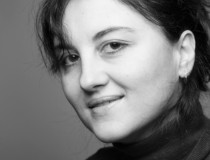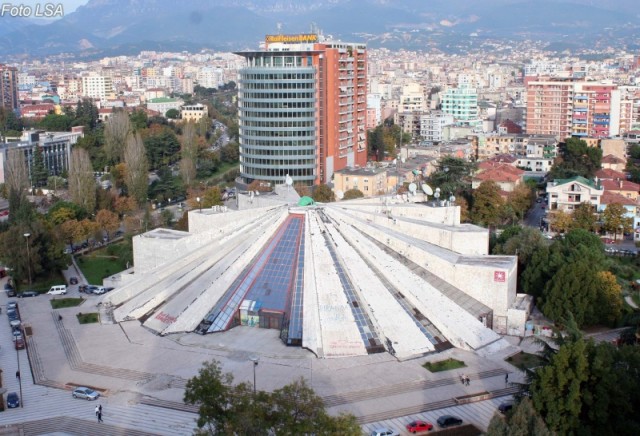
Iva Gjoni
A short story by Iva Gjoni
It was said that it was similar to the pyramid of Cheops. They built it in the center of Tirana – a pyramid for the twentieth century. The pharaohs believed that the world of death was another kind of life and, therefore, filled the pyramids with gold and food. They even took their wives with them, burying them alive next to the corpses of the mummified pharaohs.
When Tirana’s pyramid was completed, it was winter. A wet winter, gloomy and dark on the black asphalt, where the neons on the sides of the streets cast their yellow lights vaguely – rows of light lined up in order. The pyramid, built in white marble with lines of windows made of black glass, was too bright on one side of the only boulevard in the capital. It was modern architecture, perhaps the first and only one of the time. Tall, slanted and new, in the form of a cone, it stood like a giant tower, a carrier of pharaohs; but this one was a small child adopted from the pharaohs’ pyramids. Was this, too, built according to astrological laws? Perhaps its peak secretly pointed at a star! Like all the other pyramids this, too, was built by slaves.
A symbol of eternity or of the idea that another world existed, it stood indifferent and cold.
Throughout history, dictators and kings have built themselves monuments and have become blinded by power and the pleasure it brings them; they have wanted to live forever. But, in the future, the pyramids that they built have been seen as work of art or testimony of the past, they’ve even been turned into museums; they are symbols of dictatorships, monuments that tell with selfishness the force of an omnipotent tyrant. But since they cannot stop time, they build pyramids. It is known that a Chinese emperor built and buried an entire army of mud. The Egyptians built labyrinths inside the pyramids so that no one would disturb the pharaoh in his other life. And the Greeks invented Hades. So the story goes on and on.
Even though our dictator was a tyrant (at least this was how it felt), I was instilled with a deep feeling of respect and awe that came, perhaps, from fear of the unknown. I saw him as untouchable, unreachable and scary, but would have loved to meet him in person and maybe would have been thrilled if he would have noticed my existence.
But I was nobody, a robot in the system, powerless and invisible.
On the evening that the pyramid was opened for the citizens, I felt anxious. Entrance was free. Even though we had no heat in our homes, the pyramid was well heated and it was so comfortable that you’d want to stay for hours inside its belly. Its interior design was new to us. Marble tiles shone under the many colorful lights. Out of curiosity, I touched the leaves of a plant in a vase that was part of the décor unable to believe that it was fake. Yes. A plastic plant!
Photographs of the dictator’s (I don’t know if I can call him “our leader.” He stayed in power for many years. Was it the people’s will? Did he turn himself into a king? Was he a king?) childhood until his late days were displayed in admirable collages. There were short video clips playing over and over again. There was the dictator smiling, walking and talking to his wife. (In fact, my mind was still pondering the fake plants.)
I was feeling so lucky that I lived in the capital. Not every citizen was able to visit the pyramid even once, yet no one could visit too often because it could arouse suspicion and generate awkward questions. Could my response have been that I liked those strange plants?
I saw the dictator’s pen, pictures (were they fake, too?) of the national war for freedom and of the founding of The Party (the communist party). But the plants, ah, those plants! How real they seemed!
In the 90’s, the pyramid was attacked by little scoundrels in rags, some were gypsies that climbed to the top and slid to the bottom on the slanted walls. All the pictures of the dictator, together with the clips on the TV screens, were tossed into an old storage facility. The pyramid’s belly was emptied. Outside, in the fancy gardens positioned between marble stairs and fences, a new tradition was begun: hanging out. The youth crowded the marbled steps — girls just emerging from communism, boys wearing tight blue jeans (brought as gifts from the West or bought at the new market that sold used Western clothes). That was it. The pyramid had become a meeting place. There they smoked cigarettes and experienced platonic affairs, democratic flirtations until late into the night. The pyramid now symbolized nothingness, some kind of life that had nothing to do with death any longer. I felt bad for the plants. They were destroyed when the pyramid was vandalized (rightly) because they hated the fact that it displayed memories of the king.
Today, the pyramid in Tirana still stands — one of the few remaining relics of a pharaoh who, like the others before him, could not defy time.
